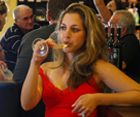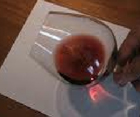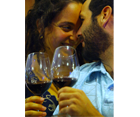How to Taste Wine
Wine tasting is intended to diagnose all the different layers of the wine, even those we do not tend to pay attention to, while drinking wine. In order to do so, we need to reserve all of our senses and concentrate. When approaching wine, it should be done with a "clean" heart, whether blindly or whether we know what we are about to taste. This is because the brain can easily affect our level of enjoyment from the wine.
Look
At first, we examine the wine with our sight – tilting the glass at 45 degrees above white paper or surface, in an adequate lit area (not in direct sunlight). We look at the edges of the wine and examine its color. If the wine is young and fresh, we expect to see shades of purple and burgundy. The older the wine is, we expect to see shades of red, orange and even brown. Such shades in young wine are not a good sign.
Smell
In the second stage, we smell the wine – first, one must swirl the glass, in order to expose it to oxygen. Swirling is done by turning the glass gently in the air, or on the table.
Now, we tilt the glass to the nose, and place our nose within the glass, while smelling the wine continuously.
It is recommended to do so with closed eyes, in order to neutralize the effects that may be around. The aromas we look for in a good wine are positive - fruits, spices, herbs, and even secondary smells such as leather, earth and fungi. Some aromas are clearly considered off, unpleasant odors, however, some aromas that are considered bad in some places, may be considered to be excellent elsewhere. This is where personal taste comes in...
Taste and Feel
In the third stage, we taste and feel the wine – we take a healthy sip of the wine, into the mouth, and gently roll the wine within the mouth, for a good few seconds. At this time, the wine warms up a bit, and we have the opportunity to concentrate and think of what we are experiencing.
The main things that we should notice in wine tasting are - the level of acidity, the level of tannin (astringency – feels like an unripe fruit), the level of sweetness, alcohol level, the level of bitterness, the degree of oiliness of the wine, and other such feelings that the wine can cause our palate.
A good wine is a wine that none of the above mentioned are missing, but also is not particularly prominent. This is considered to be a balanced wine.
Now we need to get rid of the wine in the mouth - we do so by spitting out the wine to the spittoon, this is done to stay sober and allows us to taste more wines, but certainly, the wine can be swallowed as well.
At this point, we should take note of the “after taste”– the taste that the wine leaves in the mouth after spiting it out. A good quality wine leaves a dominant taste over time.
This is a particularly desirable feature when you are looking to "spice up" your palate towards foods that will be eaten alongside the wine. It is recommended to take another sip of wine, since the second impression is always a little different than the first.
Listen
After tasting the wine, devote some attention to listening - what are other people saying about the wine, and most importantly – are they enjoying themselves?
Cheers!








